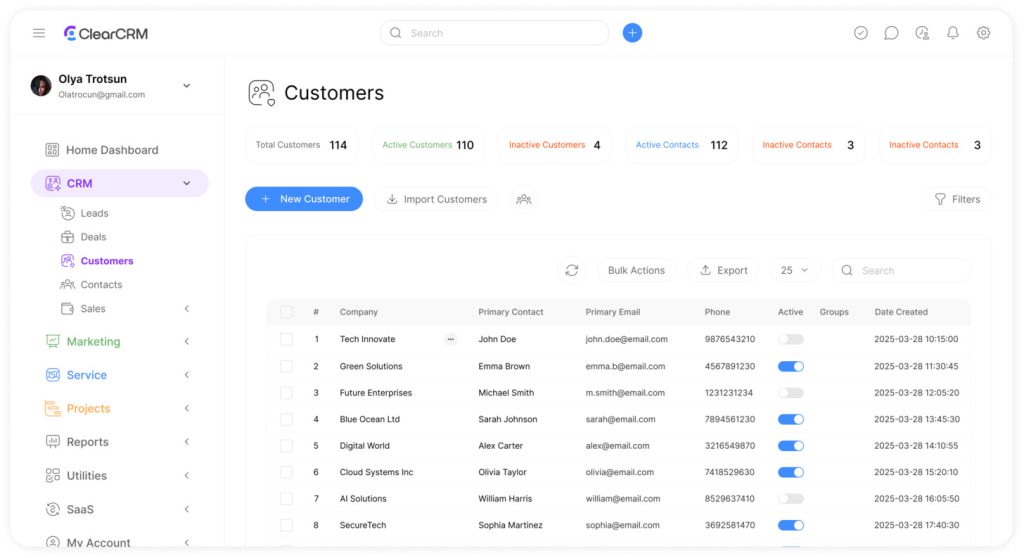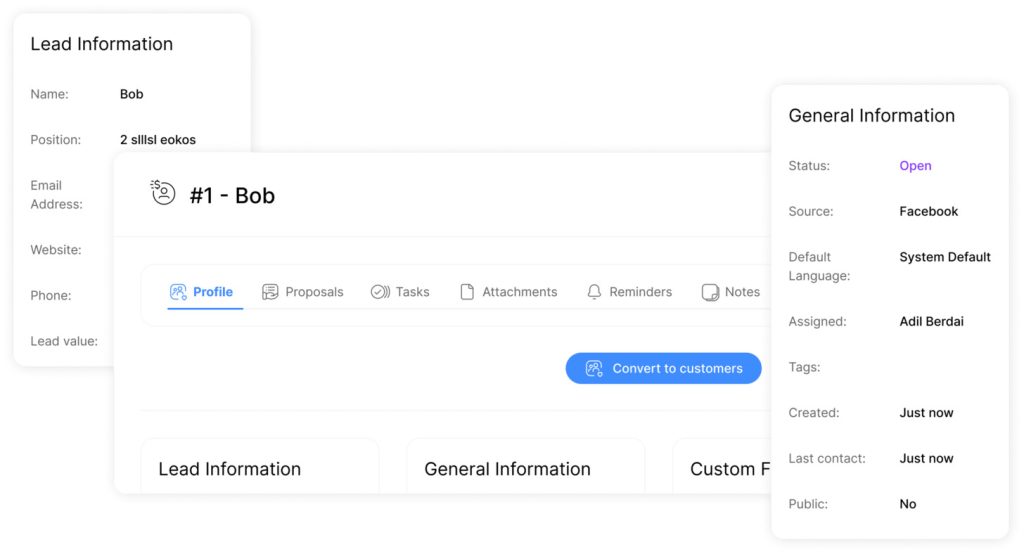Comprehensive Lead Profile for Effective Lead Management

Effective lead management is crucial for businesses seeking to enhance customer relationships and streamline operations. One key aspect of this is maintaining detailed profiles that capture a wide range of customer information.
By structuring and maintaining comprehensive customer profiles, businesses can gain a competitive edge through deeper insights and more personalized engagement. This involves incorporating essential components such as contact details, activity tracking, tagging systems, and custom fields to create a holistic view of customers.
Key Takeaways
- Detailed customer profiles are essential for effective lead management.
- Businesses that maintain robust customer profiles gain a competitive edge.
- Essential components of customer profiles include contact information, activity tracking, and custom fields.
- A holistic view of customers drives more effective sales and marketing strategies.
- Practical approaches to organizing customer data balance depth of information with usability.
Understanding Comprehensive Lead Information

Comprehensive lead information is crucial for businesses aiming to optimize their sales and marketing strategies. By maintaining detailed profiles with contact information, activity records, tags, and custom fields, businesses can unlock valuable insights into their leads’ behaviors and preferences.
The Value of Detailed Lead Profiles
Detailed lead profiles provide a comprehensive understanding of potential customers, enabling businesses to tailor their approaches effectively. With access to such detailed information, sales teams can personalize their interactions, addressing specific pain points and offering relevant solutions. This personalized approach not only enhances customer satisfaction but also increases the likelihood of conversion.
Key Components of Lead Information Management
Effective lead information management involves several key components, including contact details, activity tracking, tagging systems, and custom fields. By integrating these elements, businesses can create a holistic view of their leads, facilitating more informed decision-making. For instance, a CRM system that automates lead data collection can significantly streamline this process.
How Comprehensive Lead Data Drives Business Growth
Comprehensive lead data drives business growth by enabling more accurate sales forecasting, informing product development, and enhancing marketing campaign effectiveness. Businesses that systematically analyze lead data can identify patterns and trends, gaining competitive intelligence about market needs and emerging opportunities. This data-driven approach allows companies to allocate resources more efficiently, ultimately driving revenue growth and profitability.
- Comprehensive lead data empowers businesses to create more targeted marketing campaigns with improved engagement and conversion rates.
- By analyzing lead data, businesses can identify areas for product development and service improvements.
- Sales representatives can personalize their approach using detailed lead data, leading to better customer satisfaction.
Essential Contact Information for Effective Lead Management

Accurate contact information is the backbone of successful lead management strategies. Businesses rely on this data to communicate effectively with potential customers, tailor their marketing efforts, and ultimately drive sales.
Basic Contact Details Every Profile Should Include
At a minimum, every lead profile should contain basic contact details such as name, email address, phone number, and physical address. This foundational information enables initial outreach and follow-up communications. Ensuring that these details are accurate and up-to-date is crucial for maintaining a healthy lead pipeline.
Organizing Multiple Contact Points
In today’s multi-channel world, leads may interact with a business through various contact points. Consolidating multiple touchpoints—like social media profiles, alternate emails, or phone numbers—into a single lead profile improves tracking and enables more personalized engagement. Effective lead management involves consolidating these diverse contact channels into a unified view.
Maintaining Data Accuracy and Freshness
To maintain the integrity of lead data, businesses must implement several key practices:
- Regular data cleansing protocols to identify and correct outdated or inaccurate contact information.
- Utilizing email verification services and bounce management systems to flag potentially invalid contact details.
- Creating automated workflows that prompt leads to update their own information through self-service portals or confirmation emails.
- Establishing data governance policies that assign responsibility for maintaining contact accuracy to specific team members or roles.
- Leveraging integration with third-party data providers to automatically refresh and enrich contact data with minimal manual intervention.
By focusing on these areas, businesses can ensure that their lead contact information remains a valuable asset, driving more effective lead management and ultimately contributing to improved sales outcomes.
Tracking Lead Activity for Deeper Insights

Understanding lead behavior through activity tracking can significantly enhance sales strategies. By closely monitoring how leads interact with your business, you can uncover valuable patterns and trends that inform your approach.
Types of Activities Worth Monitoring
To gain a comprehensive understanding of your leads, it’s essential to track various types of activities. These include:
- Email opens and clicks
- Website visits and page views
- Content downloads and engagement
- Social media interactions
Analyzing these activity patterns helps identify optimal engagement cadences and communication channels for different lead segments.
Creating a Chronological Activity Timeline
Organizing lead interactions into a chronological timeline provides a clear picture of their journey. This data can be used to:
- Develop lead scoring models based on demonstrated interest
- Identify content consumption patterns revealing specific pain points
- Recognize buying signals and timing windows for sales outreach
Using Activity Data to Inform Sales Strategies
By leveraging the insights gained from activity data, businesses can create personalized follow-up strategies. This involves referencing specific interactions and demonstrating attentiveness to the lead’s interests. Implementing predictive analytics that use historical activity patterns can also forecast future buying behavior and optimal intervention points.
Ultimately, tracking lead activity and analyzing the resulting data enables businesses to refine their sales strategies, improving overall efficiency and effectiveness.
Implementing an Effective Tagging System
A well-structured tagging system enables businesses to categorize and analyze lead information effectively. This system is pivotal in enhancing the overall lead management process.
Benefits of Lead Tagging
Lead tagging offers numerous benefits, including improved lead segmentation, enhanced personalization, and more accurate sales forecasting. By assigning relevant tags to leads, businesses can quickly identify and target specific groups, thereby streamlining their marketing efforts.
Creating a Structured Tag Hierarchy
To maximize the effectiveness of lead tagging, it’s essential to establish a structured tag hierarchy. This involves creating a logical and consistent framework for organizing tags, ensuring that they are easily accessible and understandable by all team members.
Best Practices for Tag Management
Effective tag management requires a combination of strategic planning and ongoing maintenance. Some key practices include:
- Regularly reviewing and auditing tags to eliminate redundancy and ensure relevance.
- Establishing clear governance policies to control tag creation and usage.
- Providing comprehensive training and documentation to ensure consistent tag application across the team.
- Utilizing automated tagging rules to streamline the process and reduce manual errors.
- Conducting periodic reviews with stakeholders to ensure the tagging system remains aligned with evolving business needs.
By implementing these best practices, businesses can optimize their tagging system, leading to more efficient lead management and improved overall performance.
Leveraging Custom Fields for Comprehensive Lead Information

To maximize lead conversion, businesses must leverage custom fields to gather detailed and relevant lead data. Custom fields allow organizations to tailor their lead information collection to specific business needs, enhancing the overall quality of lead profiles.
Types of Custom Fields to Consider
Businesses can utilize various types of custom fields to capture a wide range of lead information. These include:
- Text fields for capturing specific details such as product interests or company size
- Date fields for tracking important dates like follow-up actions or event registrations
- Dropdown fields for categorizing leads based on predefined criteria such as industry or job function
By incorporating these diverse field types, organizations can create rich, nuanced lead profiles that support targeted marketing and sales efforts.
Industry-Specific Custom Field Applications
Different industries can benefit from custom fields in unique ways. For instance, in healthcare, custom fields might track patient history or specific treatment interests. In real estate, they could capture property preferences or investment goals.
| Industry | Custom Field Applications |
|---|---|
| Healthcare | Patient history, treatment interests, insurance details |
| Real Estate | Property preferences, investment goals, location interests |
| Finance | Investment portfolio, financial goals, risk tolerance |
Avoiding Custom Field Overload
Although custom fields are valuable, it’s important not to overload lead profiles with excessive data. To strike the right balance, businesses should:
- Implement a rigorous evaluation process for new custom field requests
- Create field dependencies to display relevant fields based on other profile attributes
- Develop progressive profiling strategies to prioritize critical custom fields
- Track field utilization to identify and deprecate unused fields
- Organize custom fields into logical groupings with collapsible sections
By adopting these strategies, organizations can maintain a streamlined and effective lead management system that supports their business objectives.
Integrating Lead Profiles Across Business Systems

Effective integration of lead profiles across various business systems is crucial for maintaining data consistency and enhancing operational efficiency. This integration enables businesses to leverage lead information across different platforms, ensuring that all teams have access to the same accurate and up-to-date data.
Connecting CRM with Marketing Automation
One key aspect of integrating lead profiles is connecting CRM systems with marketing automation tools. This connection allows for the seamless transfer of lead information, enabling marketers to target the right audience with personalized campaigns. By integrating these systems, businesses can automate lead nurturing processes and improve conversion rates.
Syncing Lead Data with Sales Tools
Syncing lead data with sales tools is another critical component of lead profile integration. This ensures that sales teams have real-time access to lead information, enabling them to engage with prospects more effectively. By maintaining synchronized data, businesses can reduce the risk of data discrepancies and improve sales forecasting.
Ensuring Consistent Lead Information Across Platforms
To ensure consistency across platforms, businesses should establish a single source of truth for lead information. This involves implementing data validation rules, creating automated reconciliation processes, and developing comprehensive API integration strategies. Additionally, providing user training programs can help maintain data integrity by ensuring that team members understand how information flows between systems.
| Integration Strategy | Description | Benefits |
|---|---|---|
| Data Validation Rules | Implement rules to enforce consistent formatting and prevent invalid entries. | Improved data accuracy, reduced errors. |
| Automated Reconciliation Processes | Create processes to identify and resolve discrepancies between systems. | Enhanced data consistency, reduced manual effort. |
| API Integration Strategies | Develop strategies to maintain real-time synchronization between systems. | Improved data freshness, enhanced operational efficiency. |
Data Privacy and Security Considerations
As businesses increasingly rely on lead data, ensuring the privacy and security of this information becomes paramount. Companies must implement robust measures to protect sensitive information and maintain compliance with relevant regulations.
Compliance with Data Protection Regulations
To ensure the secure handling of lead data, businesses must comply with data protection regulations such as GDPR and CCPA. This involves understanding the legal requirements for data collection, storage, and processing. For more information on our privacy practices, please review our privacy policy.
Implementing Access Controls for Lead Information
Access controls are crucial for safeguarding lead profiles. By limiting access to authorized personnel, businesses can prevent unauthorized data breaches. Implementing role-based access controls and regular audits can help maintain the integrity of lead data.
Data Retention Policies for Lead Profiles
Effective data retention policies are essential for managing lead information. Businesses should develop strategies that balance the need to retain valuable data with the requirement to minimize storage of unnecessary information. Some key considerations include:
- Developing tiered retention schedules based on lead status and engagement level.
- Implementing automated archiving workflows for inactive lead profiles.
- Creating processes for data minimization, retaining only essential information.
- Establishing protocols for secure data destruction when retention periods expire.
- Maintaining documentation to demonstrate compliance with policies for audit purposes.
By implementing these measures, businesses can ensure the privacy and security of lead data, maintaining trust with their customers and complying with regulatory requirements.
Conclusion: Maximizing the Value of Your Lead Information
To maximize the value of lead data, businesses need a strategic approach to collection and management. By creating comprehensive lead profiles that integrate contact information, activity tracking, tagging systems, and custom fields, businesses can establish a foundation for data-driven sales and marketing strategies.
Organizations that invest in structured lead information management experience measurable improvements in conversion rates, customer retention, and operational efficiency. The most effective lead management systems balance comprehensive data collection with accessibility, ensuring that information is both thorough and readily available to team members.
Key benefits of effective lead information management include:
- Enhanced ability to create targeted marketing campaigns through detailed lead profiling.
- Improved sales strategies informed by comprehensive activity tracking and analysis.
- Increased operational efficiency through streamlined data management processes.
- Better compliance with evolving data privacy regulations through regular maintenance and governance.
By implementing the strategies outlined in this guide, businesses can position themselves to build stronger customer relationships and drive sustainable growth through informed, targeted engagement. As markets continue to evolve, the competitive advantage gained through superior lead information management will only continue to grow.

